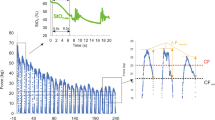Abstract
A method for scaling the muscle action is proposed and used to achieve a 3D inverse dynamic model of the human finger with all its components scalable. This method is based on scaling the physiological cross-sectional area (PCSA) in a Hill muscle model. Different anthropometric parameters and maximal grip force data have been measured and their correlations have been analyzed and used for scaling the PCSA of each muscle. A linear relationship between the normalized PCSA and the product of the length and breadth of the hand has been finally used for scaling, with a slope of 0.01315 cm−2, with the length and breadth of the hand expressed in centimeters. The parametric muscle model has been included in a parametric finger model previously developed by the authors, and it has been validated reproducing the results of an experiment in which subjects from different population groups exerted maximal voluntary forces with their index finger in a controlled posture.





Similar content being viewed by others
References
An K. N., E. Y. S. Chao, W. P. Cooney, R. L. Linscheid 1979 Normative model of human hand for biomechanical analysis. J. Biomech. 12:775–788
An K. N., E. Y. S. Chao, K. R. Kaufman Analysis of muscle and joint loads. In: Basic Orthopaedics Biomechanics, edited by V.C. Mow. New York: Raven Press Ltd., 1991, pp. 1–50
Brook N., J. Mizrahi, M. Shoham, J. Dayan 1995 A biomechanical model of index finger dynamics. Med. Eng. Phys. 17:54–63
Buchholz B., T. J. Armstrong, S. A. Goldstein 1992 Anthropometric data for describing the kinematics of the human hand. Ergonomics 35:261–273
Daams B. J. 1994 Human Force Exertion in User-Product Interaction. Backgrounds for Design. Delft: Delft University Press
Esteki A., J. M. Mansour 1997 A dynamic model of the hand with application in functional neuromuscular stimulation. Ann. Biomed. Eng. 25:440–451
Holzbaur K. R., W. M. Murray, S. L. Delp 2005 A model of the upper extremity for simulating musculoskeletal surgery and analyzing neuromuscular control. Ann. Biomed. Eng. 33:829–840
Lee J. W., K. Rim 1990 Maximum finger force prediction using a planar simulation of the middle finger. Proc. Inst. Mech. Eng. [H] 204:169–178
Pagowski S., K. Piekarski 1977 Biomechanics of metacarpophalangeal joint. J. Biomech. 10:205–209
Sancho-Bru J. L., D. J. Giurintano, A. Pérez-González, M. Vergara 2003 Optimum tool handle diameter for a cylinder grip. J. Hand Ther. 16:337–342
Sancho-Bru J. L., A. Pérez-González, M. Vergara-Monedero, D. J. Giurintano 2001 A 3-D dynamic model of human finger for studying free movements. J. Biomech. 34:1491–1500
Sancho-Bru J. L., A. Pérez-González, M. Vergara-Monedero, D. J. Giurintano 2003 A 3D biomechanical model of the hand for power grip. J. Biomech. Eng. 125:78–83
Valero-Cuevas F. J. 2000 Predictive modulation of muscle coordination pattern magnitude scales fingertip force magnitude over the voluntary range. J. Neurophysiol. 83:1469–1479
Valero-Cuevas F. J. 2005 An integrative approach to the biomechanical function and neuromuscular control of the fingers. J. Biomech. 38:673–684
Valero-Cuevas F. J., V. R. Hentz 2002 Releasing the A3 pulley and leaving flexor superficialis intact increases pinch force following the Zancolli lasso procedures to prevent claw deformity in the intrinsic palsied finger. J. Orthop. Res. 20:902–909
Valero-Cuevas F. J., F. E. Zajac, C. G. Burgar 1998 Large index-fingertip forces are produced by subject-independent patterns of muscle excitation. J. Biomech. 31:693–703
Vergara M., J. L. Sancho-Bru, A. Pérez-González 2003 Description and validation of a non-invasive technique to measure the posture of all hand segments. J. Biomech. Eng. 125:917–922
Acknowledgments
This research has been supported by both the Spanish Government and the EU (FEDER funds) through the Project “PN I+D+I, PI021662.”
Author information
Authors and Affiliations
Corresponding author
Rights and permissions
About this article
Cite this article
Sancho-Bru, J.L., Vergara, M., Rodríguez-Cervantes, PJ. et al. Scalability of the Muscular Action in a Parametric 3D Model of the Index Finger. Ann Biomed Eng 36, 102–107 (2008). https://doi.org/10.1007/s10439-007-9395-6
Received:
Accepted:
Published:
Issue Date:
DOI: https://doi.org/10.1007/s10439-007-9395-6




